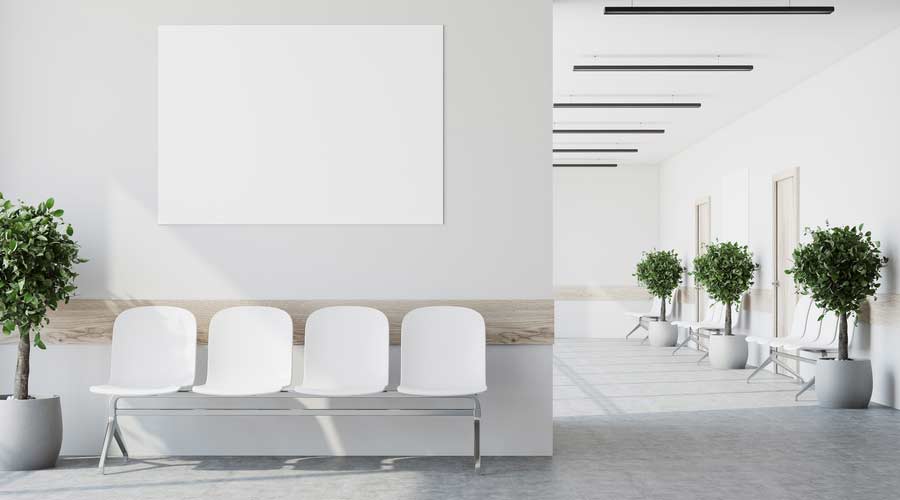Hospitals and other healthcare facilities saw expanding patient bases, even before the COVID-19 pandemic even began. But as more people retire and the virus continues to spread, demand has reached new levels.
According to the American Hospital Association, there are over 6,000 hospitals in the United States. Hundreds more hospitals and healthcare facilities will be built or expanded over the next year, providing more space and care to surrounding communities. While facilities are being built, a lot is going on behind the scenes in terms of the way rooms will be designed. Designers, architects and facility managers work closely together to ensure that their visions match and that they can create functional and comfortable spaces.
“The planning process should also be a collaborative one involving team members from the design process all the way through the build process,” Jonathan Hard, technical lead for fire protection engineering with the National Fire Protection Association (NFPA). “With an assortment of perspectives involved in planning, teams can align on the safest, most efficient way to complete the project.”
A part of that planning means looking into the appropriate flooring, paint and lighting for each space, since these factors play a role in patient care and staffing issues. Facilities managers can give insight on the way certain products impact staff in their daily work and what managers can do to better improve it. For example, understanding the benefits that lighting has on workers and patients can ensure that facilities invest in new technology.
“While the initial investment with certain products can be high, the benefits of fewer people spending hours constantly disinfecting and performing other duties, as well as the typically long-life cycle of the bulbs, will often be an overwhelming win for the facility,” says Bill Mauze, president of INVZYBL. “Most smaller hospitals are a part of an integrated delivery network (IDN) or a group purchasing organization. Those organizations negotiate contracts for their members, so most would have access to the best pricing. If they are independent or in a smaller IDN, then most manufacturers and distributors should be able to offer terms or financing. In addition, many manufacturers have different levels of pricing for both products and services. That would ideally allow the smaller facility to get the best products for what they need at the best price.”
It is important that designers choose options that spark joy within patients, residents and staff . One way to do this is through the use of paints. Leaning on more natural colors, such as soft blues and greens, creates relief during long shifts or calm during high-stress situations. Neutral colors also provide a restorative, timeless environment. Still, minimizing cost while managing upkeep, durability and the health and safety of a facility can come as a challenge, since painted areas such as hallways are high-traffic areas.
“Facilities managers are responsible for keeping the facility safe and looking fresh and clean for people occupying those spaces regularly,” says Alfredo Valiente, product marketing manager for commercial and professional brands, Benjamin Moore. “It is all a balancing act that facilities managers need to perform when painting these spaces. Paints that require extra work, unforeseen issues and frequent maintenance are the worst choices. They should look to avoid inexpensive and discount brands because that will result in constant re-painting and increased cost. Facility managers in healthcare facilities should prioritize paints that are durable, easy to clean, low odor and low or zero VOCs to ensure the safety of the painter and people occupying those spaces.”
Just as wall colors can differ for a given area, so can flooring. Back-of-house options include more downplayed sheet products, while entrances, lobbies and lounge spaces can use custom terrazzo or carpet. Flooring allows managers to be creative in ways that many patients and visitors normally do not expect. It all comes down to the aesthetic expectations that managers have and the cleaning protocols for a given space.
“Entrances and corridors will have high-traffic foot loads,” says Rocky Berg, AIA and principal with three. “Good choices here would be luxury vinyl tile, vinyl composition tile, rubber and sheet vinyl. For procedure rooms, designers tend toward sheet rubber or linoleum because seams can be eliminated, and they are more cushioned than VCT or sheet vinyl. LVT, sheet vinyl, linoleum and carpet are the options here as they allow for extended design opportunities, easy maintenance, as well as quick turnaround times on installation.”
Interior design plays an important role in healthcare facilities because it can improve the wellbeing of patients and staff. Managers who make uninformed decisions on the designs can impact patient care and lose staff.
Mackenna Moralez is the assistant editor with Healthcare Facilities Today.

 Turning Facility Data Into ROI: Where Healthcare Leaders Should Start
Turning Facility Data Into ROI: Where Healthcare Leaders Should Start Sutter Health Breaks Ground on Advanced Cancer Center and Care Complex
Sutter Health Breaks Ground on Advanced Cancer Center and Care Complex Imperial Beach Community Clinic Caught Up in Email Cyberattack
Imperial Beach Community Clinic Caught Up in Email Cyberattack Social Media Driving Rise in Trade Jobs
Social Media Driving Rise in Trade Jobs North Carolina Children's Receives $25M Gift from Coca-Cola Consolidated
North Carolina Children's Receives $25M Gift from Coca-Cola Consolidated